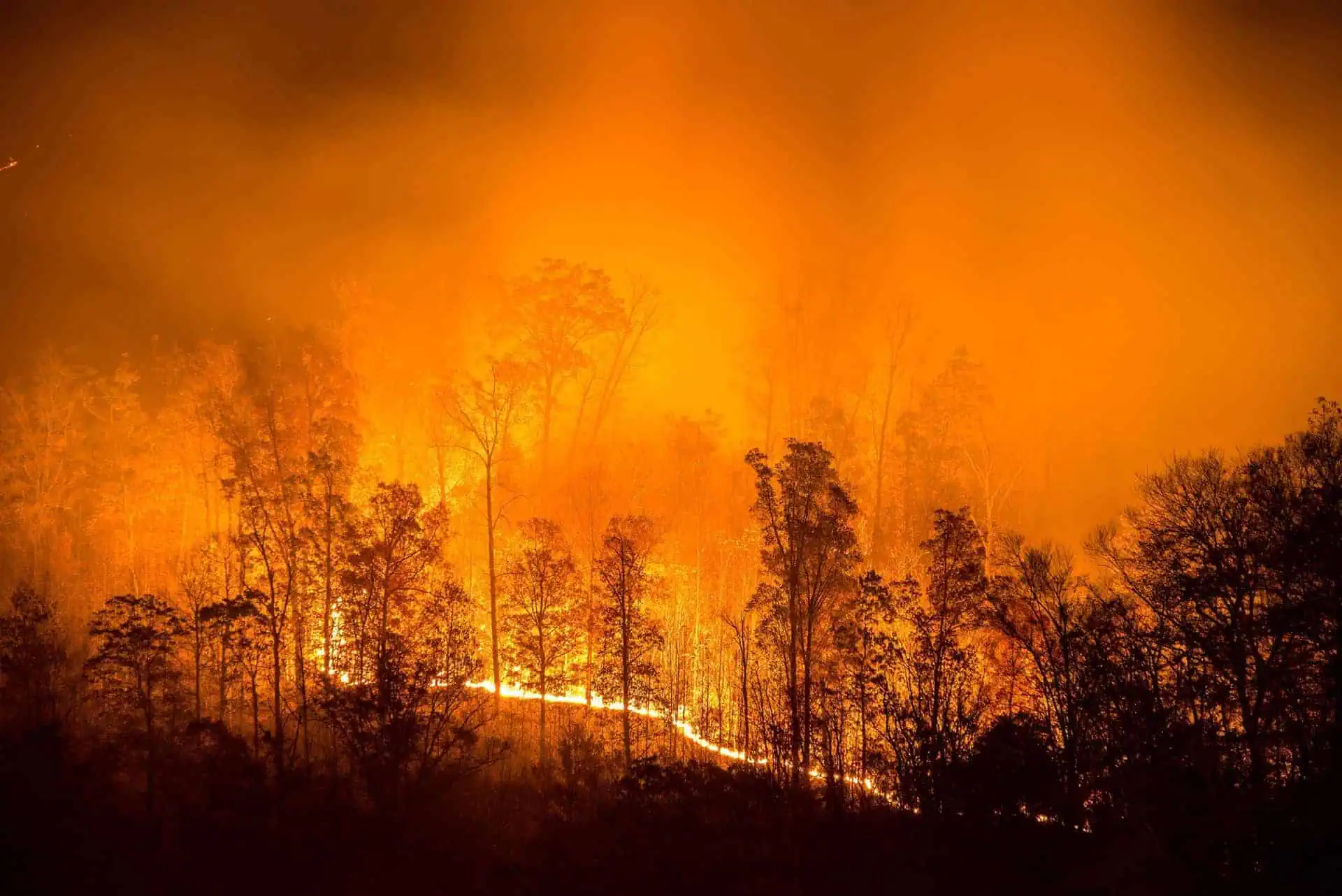FAQ: How Much of Lahaina Has Burned?
- Last Updated: July 14th, 2025

Attorney Jessica Paluch-Hoerman, founder of TruLaw, has over 28 years of experience as a personal injury and mass tort attorney, and previously worked as an international tax attorney at Deloitte. Jessie collaborates with attorneys nationwide — enabling her to share reliable, up-to-date legal information with our readers.
Legally Reviewed
This article has been written and reviewed for legal accuracy and clarity by the team of writers and legal experts at TruLaw and is as accurate as possible. This content should not be taken as legal advice from an attorney. If you would like to learn more about our owner and experienced injury lawyer, Jessie Paluch, you can do so here.
Fact-Checked
TruLaw does everything possible to make sure the information in this article is up to date and accurate. If you need specific legal advice about your case, contact us by using the chat on the bottom of this page. This article should not be taken as advice from an attorney.
Key takeaways:
- The destructive fire in Lahaina is now 100% contained, as confirmed by an official update from the County of Maui on September 4th.
- 2,200 homes, apartment buildings, and other structures were damaged or destroyed, and over 2,170 acres were burned in the devastating wildfires engulfing Lahaina, Maui.
- The cost to rebuild is estimated to exceed $5.5 billion, according to the Pacific Disaster Center and the Federal Emergency Management Agency.
Overview of How Much of Lahaina Has Burned
Question: How much of Lahaina has burned?
Answer: More than 2,200 homes, apartment buildings, and other structures were damaged or destroyed, and over 2,170 acres were burned in the devastating Lahaina fires.
On this page, we’ll provide an overview of the Lahaina fires of 2023, answer this question in further depther, evaluate the impact these fires have on the environment and local economy, and much more.
Intro to the Lahaina Wildfires
Local authorities have been proactive in spearheading recovery and rehabilitation efforts in the aftermath of the fires.
Awareness and access to available resources are pivotal for Lahaina’s community as they navigate the path to rebuilding.
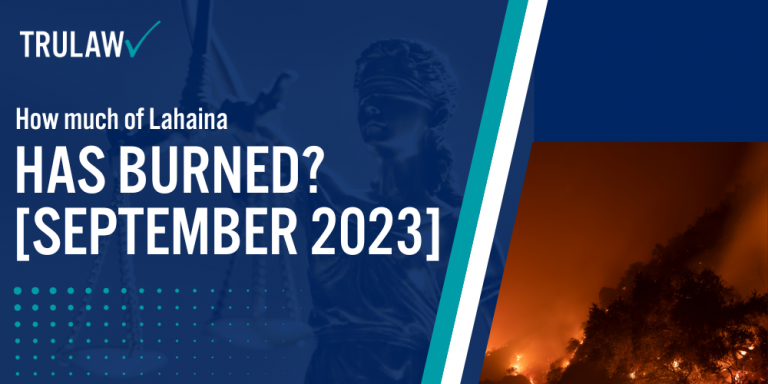
Collaborative initiatives between the public and private sectors are also playing a crucial role in expediting the restoration process and ensuring a safer future for Lahaina.
The destructive fire in Lahaina is now 100% contained, as confirmed by an official update from the County of Maui on September 4th.
The following details include how much of Lahaina has burned in the Maui wildfires:
- Over 2,200 structures damaged or destroyed: In Lahaina, more than 2,200 homes, apartment buildings, and other structures were damaged or destroyed. This includes both residential and commercial properties, leading to a significant impact on the local community and economy.
- Over 2,170 acres burned: The Lahaina fire burned over 2,170 acres of land. This not only resulted in the loss of property but also significantly impacted the local environment and wildlife.
- Significant economic impact: The fires have caused more than 1.3 billion in residential property damage, according to a preliminary estimate. The cost to rebuild is estimated to exceed 5.5 billion, according to the Pacific Disaster Center and the Federal Emergency Management Agency.
Table of Contents
Narrative of the Lahaina Fires
The Lahaina wildfire was a devastating event that forever changed the landscape and community of Lahaina, began under circumstances that remain a topic of ongoing investigation.
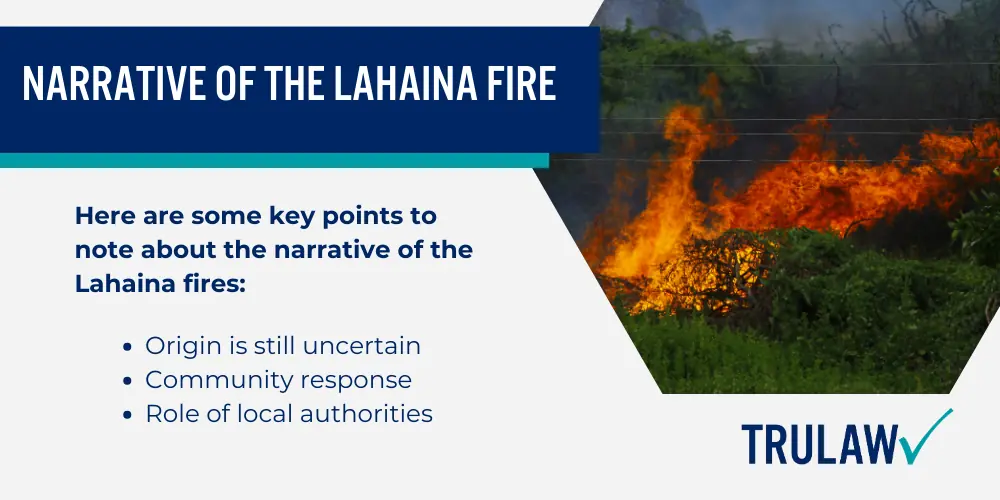
Origin and Spread
The exact origin of the fire remains under investigation, with authorities working tirelessly to determine the initial cause.
However, the conditions that allowed the fire to spread so quickly and extensively are well-documented.
Dry conditions, coupled with strong winds, created the perfect environment for the fire to thrive and spread.
Battle Against the Flames
Over the course of several days, firefighters, both local and from surrounding areas, waged a relentless battle against the flames.
They were aided in their efforts by local communities, who came together in a remarkable show of solidarity and resilience.
Role of Local Authorities
Local authorities played a pivotal role in managing the crisis.
They coordinated firefighting efforts, ensured the safety of residents, and provided timely updates to keep the public informed.
Their efforts were instrumental in eventually bringing the fire under control and minimizing the potential for further damage.
Here are some key points to note about the narrative of the Lahaina fire:
- Uncertain origin, rapid spread: The fire’s origin remains a topic of investigation, but the rapid spread, fueled by dry conditions and strong winds, is well-documented.
- Community response: Firefighters, aided by local communities, battled the flames over several days, demonstrating remarkable resilience and solidarity.
- Role of local authorities: Local authorities were instrumental in coordinating efforts, ensuring safety, and providing timely updates.
This narrative of the Lahaina fire provides a glimpse into the challenges faced during the event and the concerted efforts made to overcome them.
Lahaina Fire Damage Assessment
The Lahaina fire, a catastrophic event that has forever marked the community, resulted in a trail of destruction that is both vast and varied.
Thousands of acres were scorched, numerous buildings were destroyed, key infrastructure was damaged, and the human toll was significant.
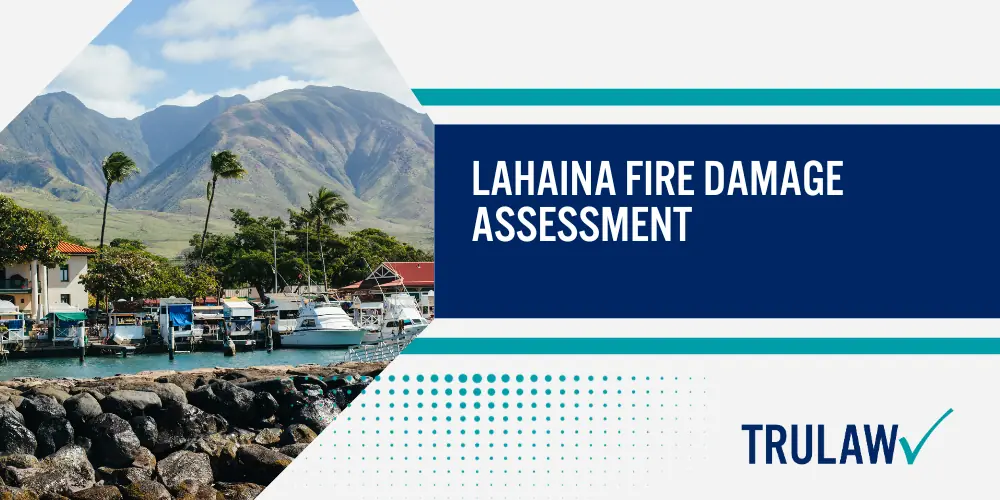
Land and Property Damage
Over 2,170 acres of land were scorched by the Lahaina fire, transforming lush landscapes into charred expanses.
The destruction was not limited to natural areas, the loss of homes and businesses added a significant financial burden to the emotional distress experienced by the community.
Infrastructure Damage
Key infrastructure, including roads and power lines, suffered extensive damage.
The destruction of these vital components of daily life disrupted transportation and communication, adding to the challenges faced by the community in the aftermath of the fire.
Human Toll
In addition to the physical injuries reported, many residents were displaced from their homes, forced to seek temporary shelter elsewhere.
The psychological impact of such displacement, coupled with the loss of personal belongings and the disruption of daily life, cannot be overstated.
Key points to note while assessing the damage caused by the Lahaina fire include, but are not limited to:
- Extensive land and property damage: Over 2,170 acres of land were scorched, and more than 2,200 residential and commercial buildings were damaged or destroyed.
- Significant infrastructure damage: Roads and power lines, crucial to daily life and communication, suffered extensive damage.
- Considerable human toll: The Lahaina fire resulted in the loss of 97 lives.
The assessment of the damage caused by the Lahaina fire provides a sobering perspective on the destructive power of such natural disasters.
Environmental Impact of the Lahaina Fire
Beyond the immediate destruction, the Lahaina fire had far-reaching and long-lasting environmental consequences.
The fire disrupted local ecosystems, caused significant harm to biodiversity, led to soil erosion, and contributed to global warming through the release of vast amounts of carbon emissions.
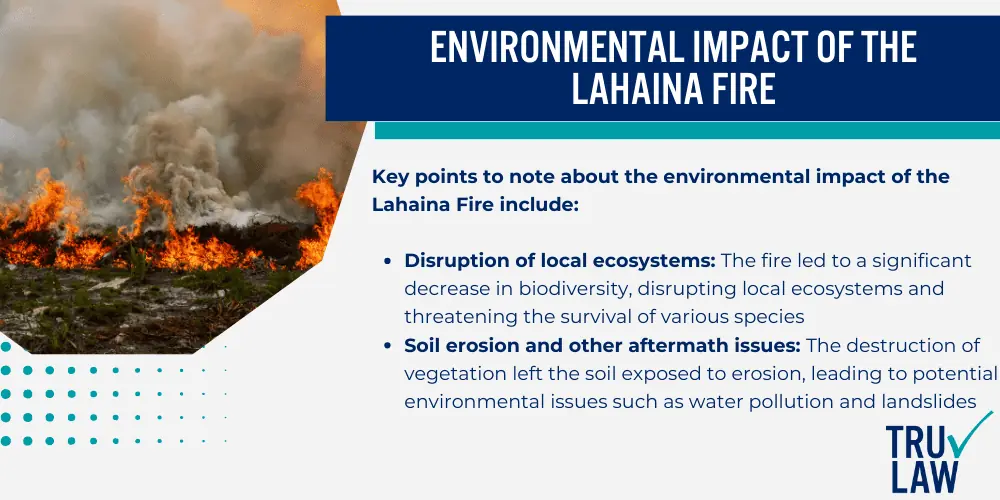
Disruption of Local Ecosystems
The fire’s rapid spread across thousands of acres resulted in the severe disruption of local ecosystems.
The loss of vegetation and wildlife habitats led to a significant decrease in biodiversity, affecting the balance of local ecosystems and threatening the survival of various species.
Soil Erosion and Other Aftermath Issues
The aftermath of the fire saw the emergence of additional environmental issues. With vegetation destroyed, the soil was left exposed and susceptible to erosion, particularly during rainfall.
This erosion can lead to further environmental damage, including water pollution and landslides, threatening the already fragile environment.
Key points to note about the environmental impact of the Lahaina fire include:
- Disruption of local ecosystems: The fire led to a significant decrease in biodiversity, disrupting local ecosystems and threatening the survival of various species.
- Soil erosion and other aftermath issues: The destruction of vegetation left the soil exposed to erosion, leading to potential environmental issues such as water pollution and landslides.
The environmental impact of the Lahaina fire underscores the far-reaching consequences of such natural disasters.
Economic Impact of the Lahaina Fire
The Lahaina fire had profound economic ramifications for the local community.
The direct damages were significant, running into millions of dollars, but the indirect impacts, such as job losses and a dip in tourism, further strained the Lahaina economy.
The local government faced the dual challenge of managing immediate relief efforts and planning for long-term economic recovery.
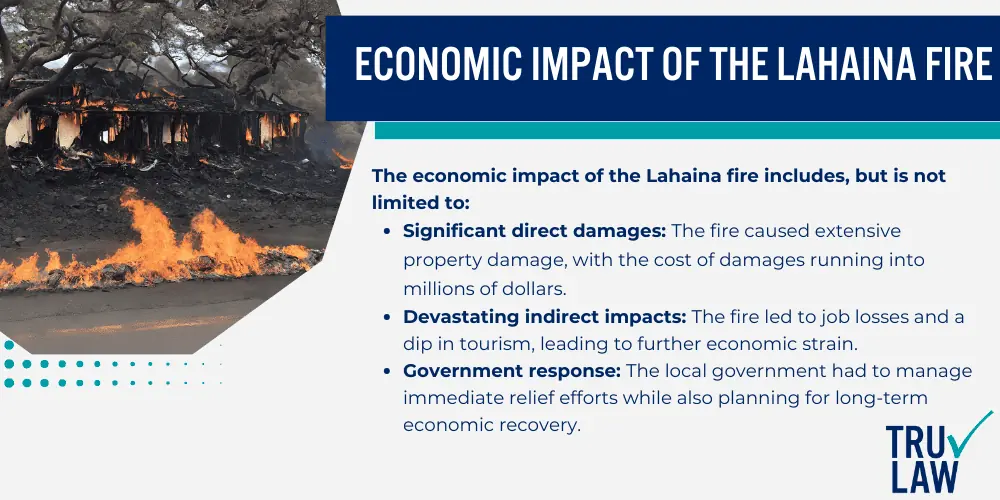
Direct Damages
The fire caused extensive property damage, with the cost of damages running into millions of dollars.
Homes, businesses, and vital infrastructure were destroyed, leading to significant financial losses for individuals and the community as a whole.
Indirect Impacts
Beyond the direct damages, the fire had indirect economic impacts that were equally devastating.
Many people lost their jobs, particularly in sectors like tourism, which were heavily affected by the fire.
The dip in tourism also had a knock-on effect on local businesses, further exacerbating the economic strain.
Government Response
The local government was tasked with managing immediate relief efforts, providing aid to displaced residents, and supporting the rebuilding process.
At the same time, they had to plan for long-term economic recovery, a complex task requiring careful resource allocation and strategic planning.
The economic impact of the Lahaina fire include, but is not limited to:
- Significant direct damages: The fire caused extensive property damage, with the cost of damages running into millions of dollars.
- Devastating indirect impacts: The fire led to job losses and a dip in tourism, leading to further economic strain.
- Government response: The local government had to manage immediate relief efforts while also planning for long-term economic recovery.
The economic impact of the Lahaina fire highlights the far-reaching consequences of such natural disasters.
Lahaina Fire Legislation and Policy Response
The Lahaina fire served as a catalyst for a comprehensive review of existing disaster management policies.
It highlighted the need for improved preparedness and response mechanisms, leading to the introduction of new legislation.
While the government’s efforts were largely appreciated, there were critiques, particularly concerning resource allocation and prioritization.
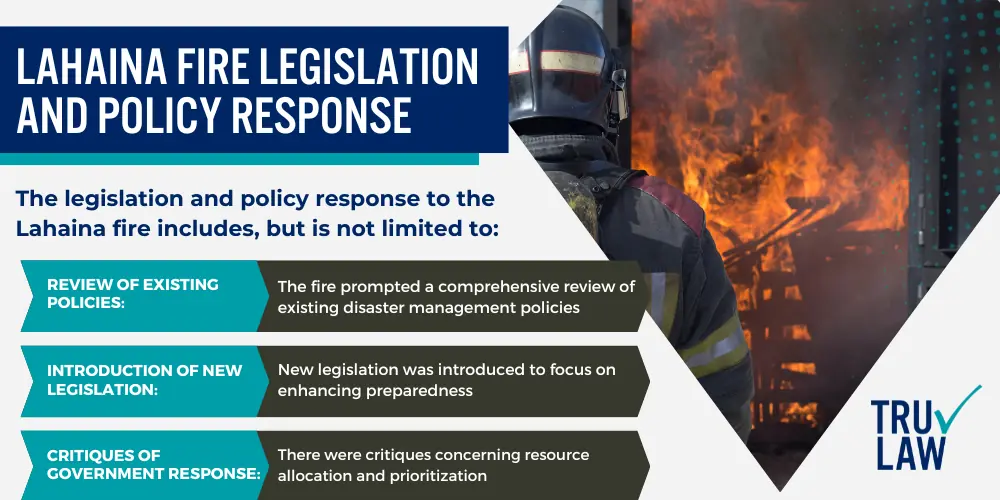
Review of Existing Policies
The devastating impact of the fire prompted a thorough review of existing disaster management policies.
This review aimed to identify gaps in the current policies and propose measures to address these gaps to better prepare for and respond to such disasters in the future.
Introduction of New Legislation
In response to the identified gaps, new legislation was introduced.
The focus of this legislation was on enhancing preparedness and improving response mechanisms.
These legislative changes aimed to strengthen the community’s resilience and capacity to manage and recover from similar events in the future.
Critiques of Government Response
While the government’s efforts to review policies and introduce new legislation were largely appreciated, there were critiques.
Some of these critiques related to the allocation of resources and prioritization of certain measures over others.
These critiques underscore the complexity of disaster management and the challenges involved in balancing various needs and considerations.
The legislation and policy response to the Lahaina fire includes, but is not limited to:
- Review of existing policies: The fire prompted a comprehensive review of existing disaster management policies.
- Introduction of new legislation: New legislation was introduced, focusing on enhancing preparedness and improving response mechanisms.
- Critiques of government response: While the government’s efforts were largely appreciated, there were critiques, particularly concerning resource allocation and prioritization.
The legislation and policy response to the Lahaina fire underscores the importance of continuous learning and adaptation in disaster management.
Lahaina's Strategies for Future Fire Preparedness
The Lahaina fires underscore the urgent need for proactive measures to prevent and manage future fire incidents.
In response to this, the community and local government have implemented several strategies aimed at mitigating future risks.
These include stricter land management practices, enhanced building codes, and significant investments in early warning systems, community education, and firefighting resources.
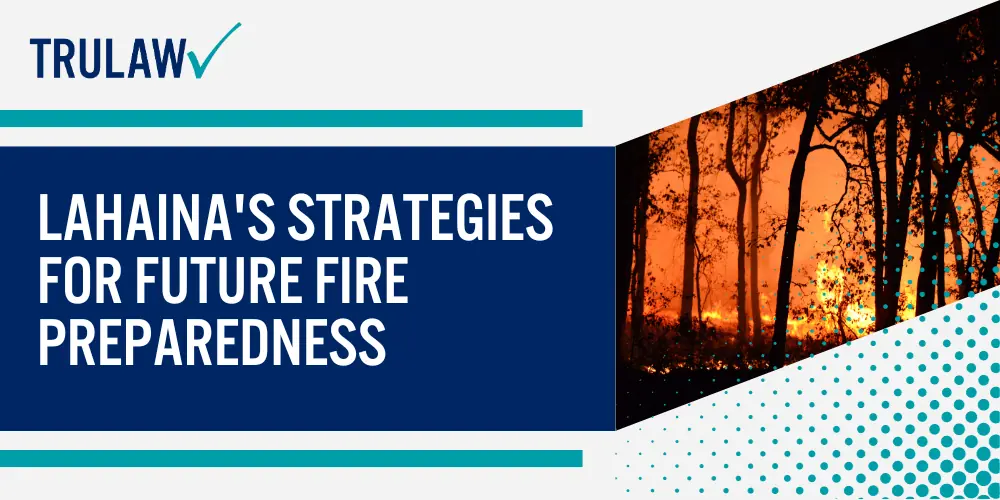
Stricter Land Management Practices
One of the key strategies adopted is the implementation of stricter land management practices.
These include measures to control:
- Vegetation growth;
- Create firebreaks;
- Proper maintenance of public and private lands.
These actions can be taken enact stricter land management practices in order to reduce the risk of fires.
Enhanced Building Codes
Building codes have been enhanced to ensure structures are better equipped to withstand fires.
These changes include the use of fire-resistant materials in construction and the incorporation of fire safety measures in building designs.
Investments in Early Warning Systems and Resources
Significant investments have been made in early warning systems to ensure timely detection and response to potential fire incidents.
Additionally, resources have been allocated to equip and train firefighting teams, enhancing their capacity to respond effectively to fires.
Community Education
Community education initiatives have been prioritized to increase public awareness about fire risks and safety measures.
These initiatives aim to empower residents with the knowledge and skills to protect themselves and their properties during fire incidents.
Lahaina’s strategies for future fire preparedness include:
- Stricter land management practices: Measures have been implemented to control vegetation growth, create firebreaks, and ensure proper maintenance of lands.
- Enhanced building codes: Building codes have been revised to incorporate fire safety measures and the use of fire-resistant materials.
- Investments in early warning systems and resources: Significant investments have been made in early warning systems and firefighting resources.
- Community education: Community education initiatives have been prioritized to increase public awareness about fire risks and safety measures.
The strategies adopted by Lahaina for future fire preparedness highlight the community’s commitment to learning from past experiences and taking proactive measures to mitigate future risks.
Reflecting on the Lahaina Fire
As the community rebuilds and recovers, there’s a renewed focus on resilience, preparedness, and unity.
The fire’s aftermath has been a testament to the indomitable spirit of Lahaina’s residents.
Despite the immense challenges, they have shown remarkable resilience, coming together to support each other and rebuild their community.
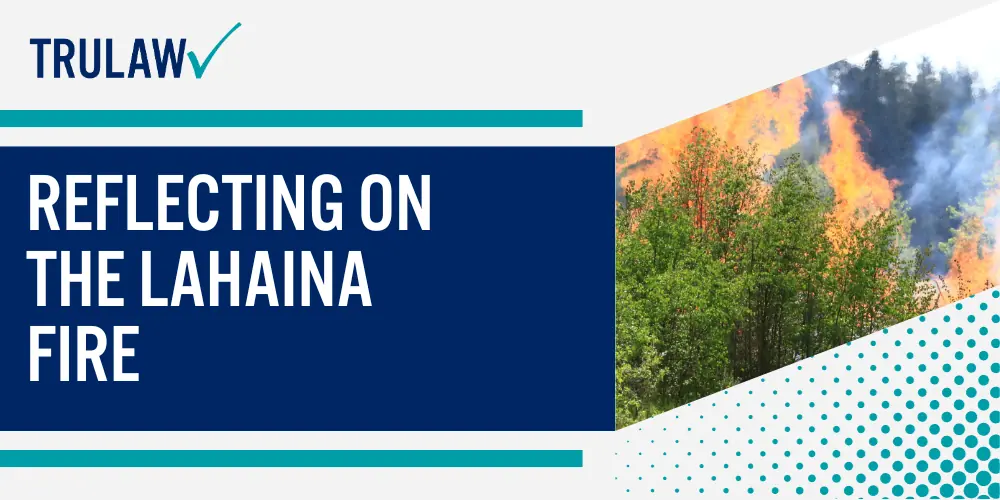
This unity, coupled with the lessons learned from the fire, has strengthened the community’s resolve to forge a brighter future.
The strategies adopted for future fire preparedness reflect this resolve.
Stricter land management practices, enhanced building codes, investments in early warning systems, and prioritization of community education are all proactive measures aimed at mitigating future risks.
These measures underscore the community’s commitment to learning from past experiences and taking proactive steps to ensure their safety and resilience.
The Lahaina Fire also prompted a comprehensive review of disaster management policies and the introduction of new legislation.
This response underscores the importance of continuous learning and adaptation in disaster management.
While there were critiques, particularly concerning resource allocation and prioritization, these discussions contribute to the ongoing improvement of disaster management strategies.
Maui Fire Lawsuit Frequently Asked Questions
-
The Lahaina fire resulted in the burning of over 2,170 acres of land.
This extensive area of scorched earth not only represents the physical damage caused by the fire but also signifies the far-reaching environmental and socio-economic implications that ensued.
The fire’s impact was felt beyond the immediate destruction of natural landscapes, affecting local ecosystems, property, and infrastructure.
The Lahaina fire serves as a stark reminder of the unpredictable power of nature and underscores the importance of proactive measures for future fire preparedness.
-
This extensive area of scorched earth resulted not only in the loss of natural landscapes but also in the disruption of local wildlife habitats.
The fire led to a significant decrease in biodiversity, disrupting the balance of local ecosystems and threatening the survival of various species.
The loss of vegetation also left the soil exposed to erosion, leading to potential environmental issues such as water pollution and landslides.
The aftermath of the Lahaina fire underscores the far-reaching environmental consequences of such natural disasters.
It serves as a reminder of the importance of proactive measures for future fire preparedness to protect and preserve our local ecosystems.
-
The Lahaina fire resulted in extensive property damage, with more than 2,200 structures, both residential and commercial, being damaged or destroyed.
This widespread property damage had significant financial implications for the community, leading to substantial economic strain.
The destruction of homes and businesses not only resulted in financial loss but also displaced many residents, adding to the challenges faced in the aftermath of the fire.
The Lahaina fire serves as a stark reminder of the devastating impact of such natural disasters on communities and underscores the importance of proactive measures for future fire preparedness to protect properties and lives.
-
In response to the Lahaina fire, several proactive measures have been implemented to prepare for future fire incidents.
These strategies aim to mitigate future risks and enhance the community’s resilience.
One of the key strategies adopted is the implementation of stricter land management practices, including measures to control vegetation growth and create firebreaks.
Building codes have also been enhanced to ensure structures are better equipped to withstand fires, with a focus on the use of fire-resistant materials and the incorporation of fire safety measures in building designs.
Additionally, resources have been allocated to equip and train firefighting teams, enhancing their capacity to respond effectively to fires.
Community education initiatives have also been prioritized to increase public awareness about fire risks and safety measures.
These initiatives aim to empower residents with the knowledge and skills to protect themselves and their properties during fire incidents.
These measures reflect Lahaina’s commitment to learning from past experiences and taking proactive steps to ensure the community’s safety and resilience in the face of potential fire incidents.
-
The direct damages from the Lahaina fire were significant, running into millions of dollars due to the destruction of homes, businesses, and vital infrastructure.
Beyond the direct damages, the fire had indirect economic impacts that were equally devastating.
Many people lost their jobs, particularly in sectors like tourism, which were heavily affected by the fire.
The dip in tourism also had a knock-on effect on local businesses, further exacerbating the economic strain.
The local government was tasked with managing immediate relief efforts, providing aid to displaced residents, and supporting the rebuilding process.

Managing Attorney & Owner
With over 25 years of legal experience, Jessica Paluch-Hoerman is an Illinois lawyer, a CPA, and a mother of three. She spent the first decade of her career working as an international tax attorney at Deloitte.
In 2009, Jessie co-founded her own law firm with her husband – which has scaled to over 30 employees since its conception.
In 2016, Jessie founded TruLaw, which allows her to collaborate with attorneys and legal experts across the United States on a daily basis. This hypervaluable network of experts is what enables her to share the most reliable, accurate, and up-to-date legal information with our readers!
Additional Maui Fire Lawsuit resources on our website:
Here, at TruLaw, we’re committed to helping victims get the justice they deserve.
Alongside our partner law firms, we have successfully collected over $3 Billion in verdicts and settlements on behalf of injured individuals.
Would you like our help?
At TruLaw, we fiercely combat corporations that endanger individuals’ well-being. If you’ve suffered injuries and believe these well-funded entities should be held accountable, we’re here for you.
With TruLaw, you gain access to successful and seasoned lawyers who maximize your chances of success. Our lawyers invest in you—they do not receive a dime until your lawsuit reaches a successful resolution!
AFFF Lawsuit claims are being filed against manufacturers of aqueous film-forming foam (AFFF), commonly used in firefighting.
Claims allege that companies such as 3M, DuPont, and Tyco Fire Products failed to adequately warn users about the potential dangers of AFFF exposure — including increased risks of various cancers and diseases.
Depo Provera Lawsuit claims are being filed by individuals who allege they developed meningioma (a type of brain tumor) after receiving Depo-Provera birth control injections.
A 2024 study found that women using Depo-Provera for at least 1 year are five times more likely to develop meningioma brain tumors compared to those not using the drug.
Suboxone Tooth Decay Lawsuit claims are being filed against Indivior, the manufacturer of Suboxone, a medication used to treat opioid addiction.
Claims allege that Indivior failed to adequately warn users about the potential dangers of severe tooth decay and dental injuries associated with Suboxone’s sublingual film version.
Social Media Harm Lawsuits are being filed against social media companies for allegedly causing mental health issues in children and teens.
Claims allege that companies like Meta, Google, ByteDance, and Snap designed addictive platforms that led to anxiety, depression, and other mental health issues without adequately warning users or parents.
Transvaginal Mesh Lawsuits are being filed against manufacturers of transvaginal mesh products used to treat pelvic organ prolapse (POP) and stress urinary incontinence (SUI).
Claims allege that companies like Ethicon, C.R. Bard, and Boston Scientific failed to adequately warn about potential dangers — including erosion, pain, and infection.
Bair Hugger Warming Blanket Lawsuits involve claims against 3M — alleging their surgical warming blankets caused severe infections and complications (particularly in hip and knee replacement surgeries).
Plaintiffs claim 3M failed to warn about potential risks — despite knowing about increased risk of deep joint infections since 2011.
Baby Formula NEC Lawsuit claims are being filed against manufacturers of cow’s milk-based baby formula products.
Claims allege that companies like Abbott Laboratories (Similac) and Mead Johnson & Company (Enfamil) failed to warn about the increased risk of necrotizing enterocolitis (NEC) in premature infants.
Here, at TruLaw, we’re committed to helping victims get the justice they deserve.
Alongside our partner law firms, we have successfully collected over $3 Billion in verdicts and settlements on behalf of injured individuals.
Would you like our help?
